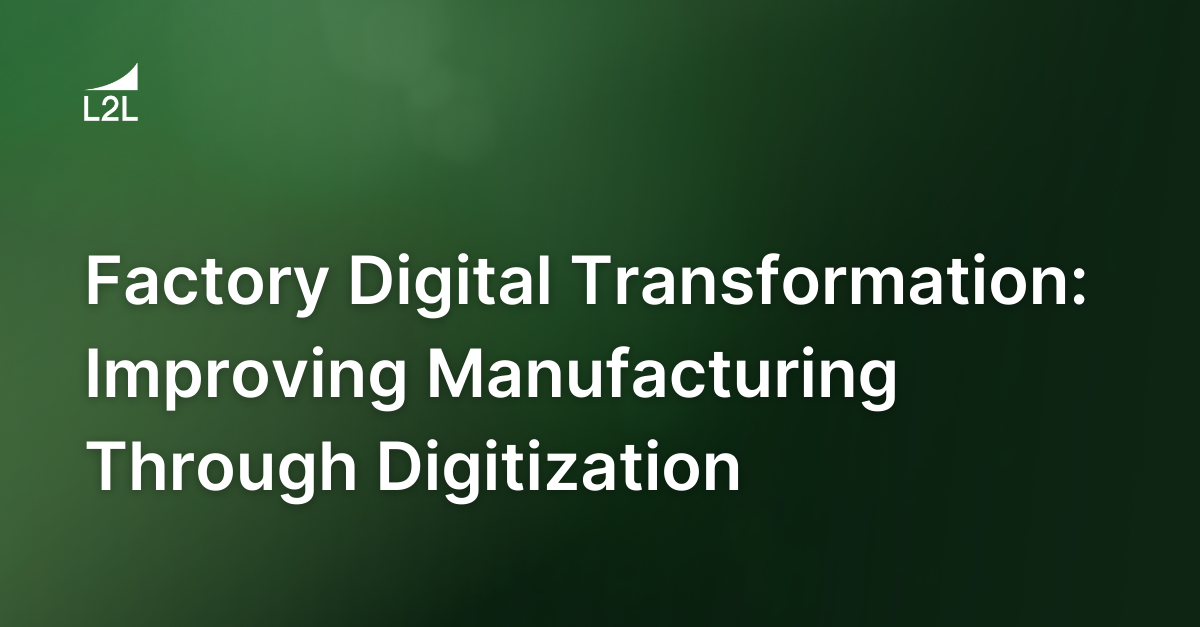
Estimated read time: 9 minutes
You’ve probably heard the term “digital transformation” a million times by now. It’s the next big thing, and, as is becoming increasingly evident, it’s not something the manufacturing industry can afford to ignore.
The truth, however, is that the term itself can be a bit misleading. The word “transformation” makes it sound like your manufacturing company is a caterpillar — a simple, delicate creature that must encase itself in a cocoon before becoming something spectacular.
But you’re not a caterpillar. You don’t have time to sit in a cocoon and wait for a transformation to occur; you have to figure it out yourself — all while continuing to juggle production goals, supply chain disruption, worker shortages and more. That means digital transformation is an active and often challenging process.
For this reason, it’s important to step back and appreciate why you’re creating a digital transformation initiative in the first place. Smart manufacturing, data analytics, new technology — is it all worth the trouble?
Here’s why we’re so convinced the answer is yes.
The foundation for digital transformation
The most important thing to remember about digital transformation in manufacturing is that the foundation is already in place.
That’s right: You may not feel like yours is a full-blown smart factory just yet, but the truth is that you’ve been laying the groundwork for this transformation over the course of several years. Sure, you may have some outdated processes layered over that groundwork (looking at you, spreadsheets!), but the basics are there. It’s all about your roots — the elements that have guided your production process, supply chain navigation and even asset management techniques since you first opened your doors. That’s why it makes so much sense for manufacturers to embrace digital transformation: You’re already working on it.
Here are a few key elements of digital transformation you’ve always had in your back pocket:
-
Common sense: Manufacturing and common sense have always gone hand in hand. Chances are, things that don’t make sense simply aren’t going to work and, thus, aren’t worth your time. That’s the same approach you should use when it comes to digital transformation. By letting common sense be your guiding light, you can avoid falling for empty promises and instead leverage digital transformation in ways that actually line up with reality.
-
Waste reduction: Manufacturing has a long history of trying to avoid waste; just look at the entire concept of lean manufacturing (regardless of your feelings on that one, you do have to admit that the bones are good). It’s a natural inclination toward doing things the simple way, and that can come in handy when planning your digital transformation. After all, with so much new technology and so many solutions to sift through, it’s important to stay focused on decisions that will deliver value without creating waste in other areas.
-
Human value: Say what you want about automation, artificial intelligence and machine learning — technology is still no match for the human brain or your ability to problem solve and act. People can do things robots will never be able to replicate. However, this instinctive protection of human value isn’t contrary to the goals of digital transformation; in fact, it’s complementary. That’s because automation can be leveraged to complete simple or repetitive tasks, freeing your teams to focus time and energy on areas where they really shine (like creative thinking and problem solving).
So, what does this mean for you? Simple: You just need to go back to your roots and begin building your digital transformation strategy around the values you already have in place. With this approach, the digital transformation process feels like less of an unknown. You’ve been thinking this way for years; now you just need to take those thoughts and digitize them.
How digital transformation improves on the old ways
Although you already have the foundation for your digital transformation project, it’s important to remember that this journey is all about improvement. Digitization isn’t about taking your old habits and doing the exact same things on a computer; it’s about expanding your horizons and leveraging data analytics and new technology like automation to make a difference in your production environment.
That means you can’t take your foundational values and rebuild exactly what you had before. Digital transformation is an opportunity to really reinvent the manufacturing process — but that’s a door you have to actively choose to walk through.
Of course, it helps to know what the door looks like — so here are a few examples of how digitization can improve production processes, supply chain management and the manufacturing industry overall:
Data capture
Data capture is perhaps the best example of how inefficient the “old ways” really are. Without any element of smart manufacturing, data capture mostly exists in the form of manual entry on whiteboards or spreadsheets. That’s not just a huge time sink — it’s also an open invitation for all kinds of human error, which compromises operational efficiency and can hurt the entire manufacturing operation.
The good news is that digital transformation improves on the old approach to data capture. Instead of forcing you to manually enter information into little boxes, digital manufacturing leverages automation to capture real-time data from equipment, users and other sources, all at the same time. This information is sent to a centralized database, where key statistics are displayed side-by-side and updated regularly. The result is a complete, accurate, real-time view of everything happening on the plant floor, from production efficiency to maintenance work orders.
Response management
Before digital transformation entered the scene, response management was primarily a product of crossed fingers. You had two options: either wait until something goes wrong and scramble to fix it, or hazard a guess about key issues without any significant data and hope you’re on the right track.
Because neither of those options is particularly appealing, it makes sense to lean on digital transformation as a way to solve this manufacturing problem. That’s because a smart factory is informed and directed by data analytics instead of guesswork. As a result, response management becomes a much more organized, precise process — one that helps you make sure you’re always doing the right thing at the right time. Solutions like automation allow the appropriate teams to be notified the minute a red flag is raised, while data analytics help you keep track of what worked, what didn’t and why.
Planned maintenance
Maintenance is a huge part of life for any manufacturer, but the old ways made it inefficient, frustrating and often wasteful. Of course, you were doing the best with what you had — but now, thanks to smart manufacturing, there’s a better way.
Instead of responding to issues with knee-jerk reactions and wasting resources on short-term fixes, a digital factory uses sensors and other devices to intelligently analyze patterns. These patterns are turned into insights that can be used to guide your maintenance decisions, helping you prevent some issues from occurring and allowing you to respond more effectively to others. (Hint: That's called predictive maintenance, and it's a pretty big deal.) That means you’ll use your resources more wisely, eliminate unnecessary work orders and even improve the reliability and performance of your equipment.
The future of digital transformation in manufacturing
You’ve seen why digital transformation makes sense for manufacturers and how digitization is improving the entire manufacturing sector — but we’re talking about constant progress here. What happens when you’ve “completed” your digital transformation journey?
Trick question — this journey doesn’t have a finish line.
That’s because the whole idea is based on evolution. Your digital transformation strategy should help you adapt to new technology as it arises, giving you a foundation upon which to build even bigger and better things.
Of course, as technology changes and the definition of digitization continues to expand, digital transformation as a concept must also grow to encompass new manufacturing needs and goals. That’s why it’s often helpful to look ahead and find out what the future of digital transformation actually looks like:
-
It’s becoming more popular. Although only 24% of surveyed manufacturers have a digital transformation strategy, 30% plan to invest more heavily in this solution in 2022 and beyond. What does this mean? Well, if you’ve already started your journey, you’re in good company; if you haven’t, you’ll probably want to think about it because it’s difficult to catch up once you’ve been left behind.
-
It’s good for your IT teams. If your IT department has been begging you not to stockpile new technology and call it digital transformation, they’re absolutely right. The future of digital transformation is all about identifying when and where it makes sense to implement new tech, helping you avoid the temptation to grab every shiny device that catches your eye.
-
It keeps you flexible. Digital transformation may not be the fountain of youth, but it helps keep manufacturers spry by giving you the opportunity to continuously adapt your approach — an especially important element of facing the future. If you never become stagnant, you’ll be able to stay competitive, flexible and highly relevant to partners or customers.
-
It provides support in tough times. As the COVID-19 pandemic has proven, supply chain disruptions and other challenges can come in all shapes and sizes. If you want to navigate future uncertainties with confidence, let digital transformation give you the visibility you need to make consistently solid decisions based on real data and analytics.
Digital transformation is waiting - are you ready?
Digital transformation in manufacturing isn’t about building a cocoon, settling in and waiting for change. It’s about stepping up and taking an active role in rebuilding the industry — but it all starts with a foundation you’ve been building for years. Elements like common sense, waste reduction and human value are critical when it comes to digital transformation, and, lucky for you, they’re probably tried and true in your very own plant.
When employing this framework, it’s important to avoid copying yourself or becoming “Version 2” of whatever you were before. Instead, you need to truly evolve. Take those underlying values, erase the outdated processes layered on top and build something new — something that embodies the spirit of “transformation.”
As you grow and change, keep in mind that digital transformation isn’t going anywhere. Once you start this journey, you’ll have the support you need to constantly innovate, stay current with new technology and learn from all the latest manufacturing best practices.
So, that’s how the manufacturing industry is improving through digitization — but how can you make it happen?
The good news: It all comes down to a Smart Manufacturing Platform. This software is the first step in digital transformation, helping you link existing values with new approaches to achieve digital manufacturing success.
The better news: You can start the journey right now by booking a demo of our platform. Digital transformation is waiting — are you ready to jump in?
Revisions
Original version: 18 July 2024
Written by: Evelyn DuJack
Reviewed by: Daan Assen
Please read our editorial process for more information
Related Posts
Subscribe to Our Blog
We won't spam you, we promise. Only informative stuff about manufacturing, that's all.




